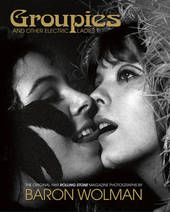
|
Groupies: The Rolling Stone Photographs
Hardback
Main Details
| Title |
Groupies: The Rolling Stone Photographs
|
| Authors and Contributors |
By (author) Holly George-Warren
|
|
Photographs by Baron Wolman
|
| Physical Properties |
| Format:Hardback | | Pages:192 | | Dimensions(mm): Height 300,Width 240 |
|
| Category/Genre | Individual photographers |
|---|
| ISBN/Barcode |
9781851497942
|
| Classifications | Dewey:779.24092 |
|---|
| Audience | |
|---|
| Illustrations |
200 black & white illustrations
|
|
Publishing Details |
| Publisher |
ACC Art Books
|
| Imprint |
ACC Editions
|
| Publication Date |
28 October 2015 |
| Publication Country |
United Kingdom
|
Description
She got her man. He was the cat they were all after and she got him." (Opening quote from the original Rolling Stone featuring The Groupies.) The 1960s were a time of cultural revolution, with music leading the way. From small clubs to giant festivals, such as Woodstock, music became the heart of a new generation's rallying cry for love, peace and harmony. With men (mainly) leading the way on stage, the girls backstage started to create their own form of liberation too. These young girls were better known as the Groupies. Girls who loved music and the men who created it. On February 15, 1969, Rolling Stone magazine issued a "Special Super-Duper Neat Issue" called "THE GROUPIES and Other Girls," featuring the work of their chief photographer Baron Wolman. This issue would become iconic, a milestone issue, making the girls instant celebrities. With this one single issue, the Groupies arrived. Now - nearly 45 years later, ACC/Iconic Images are proud to publish - for the first time - in one single volume: Groupies, the photos of Baron Wolman. With more than 150 photographs, including never-before-seen outtakes and contact sheets, Groupies documents these women as they were in the late 1960s. From Miss Pamela (Pamela des Barres) to The Plaster Casters of Chicago, this incredible collection of photos - along with original text and interviews with several of the women today - stands as an historic social and cultural document of some very sexy girls enlightened by one of the most influential decades of the 20th century. SELLING POINTS: . Baron Wolman was the first photography editor of Rolling Stone magazine. His photographs of the icons of popular music were key to that magazine's legendary status. The Groupies was a Special Super-Duper Neat Issue of Rolling Stone published in February 1969 . The photographs have been exhibited but have never been published in book form. Here they are published in a glorious large format book along with many never-seen images and behind-the-scenes shots and interviews with the protagonists . There will be a deluxe version of the book limited to 300 copies 200 b/w images
Author Biography
Baron Wolman began the music phase of his photographic career in 1967, as the very first photographer for the new Rolling Stone magazine. He went on to capture the 60s pop rock explosion, including: Janis Joplin, the Rolling Stones, the Who, Jimi Hendrix, Pink Floyd, Bob Dylan amongst many more. "I see myself as a kind of voyeur ... I'm happiest when I'm invisible and watching. I just love to watch. I'm a chameleon and can adapt myself to the situation, and that, to me, is one of the gifts that I was given naturally, and that's how you get honest pictures."
ReviewsMr. Wolman's view of the women as style icons comes into sharp focus thanks to a new coffee-table book, Groupies and Other Electric Ladies." It collects his published portraits along with outtakes, contact sheets, the original articles from the issue and new essays that put the subjects into a modern context. The thick paper stock and oversize format emphasizes Mr. Wolman's view of the groupies as pioneers in hippie frippery. -- Jim Farber New York Times, November 11, 2015 'Groupies' can be understood as an unapologetic celebration of how a coterie of self-liberated women ultimately chose to explore that complex, ancient ideato see what happens when a person comes at beauty with beauty, when she gives herself over, entirely, to an abstraction. -- Amanda Petrusich The New Yorker, December 29, 015
|